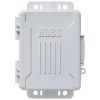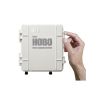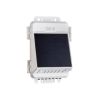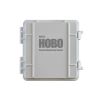HOBO ECH2O 10HS Soil Moisture Smart Sensor
Features
- Provides data directly in volumetric water content
- High-frequency (70 MHz) circuit provides good accuracy even in high-salinity and sandy soils
- Compatible with Onset stand-alone and web-based weather stations
- Free ground shipping
- Expedited repair and warranty service
- Lifetime technical support
- More
Overview
The HOBO ECH2O 10HS soil moisture smart sensor measures a large 1-liter volume of soil, providing a more accurate picture of average soil moisture. The sensor integrates the field-proven 10HS Sensor and a 12-bit A/D, providing ±3% accuracy in most soil conditions and ±2% accuracy with soil-specific calibration.
Mechanics
The 10cm probes measure soil moisture over a larger volume of soil, helping to average out any soil variability. Readings are provided directly in volumetric water content. The sensor's high-frequency design minimizes salinity and textural effects and gives it a wide measurement range.
Measurement range in soil: 0 to 0.570 m³/m³ (volumetric water content)
Accuracy:
±0.033 m³/m³ (±3.3%) typical 0 to +50°C (+32° to +122°F) for mineral soils up to 10 dS/m
±0.020 m³/m³ (±2%) with soil specific calibration
Resolution: 0.0008 m³/m³ (0.08%)
Soil probe dimensions: 160 x 32 x 2 mm (6.5 x 1.25 x 0.08 in.)
Weight: 190 grams (6.7 oz)
Decagon probe part no.: 10HS
Sensor operating temperature:
0° to +50°C (+32° to +122°F). Although the sensor probe and cable can safely operate at below-freezing temperatures (to -40°C/F) and the smart sensor tube (the white portion of the sensor cable that houses the electronics) can be exposed to temperatures up to +70°C (+158°F), the soil moisture data collected at these extreme temperatures is outside of the sensor's accurate measurement range. Extended temperatures above +50°C (+122°F) will decrease logger battery life when using for the S-SMD-M005 smart sensor.
Volume of influence: 1 liter (33.8 oz)
Sensor frequency: 70 MHz
Bits per sample: 12
Number of data channels: 1
Measurement averaging option: No
Cable length available: 5 m (16 ft)
Length of Smart Sensor network cable: 0.5 m (1.6 ft)
In The News
Monitoring Aquatic Ecosystems: How Science Drives Waterway Management in Northwest Georgia
The University of Georgia is home to multiple labs that focus on monitoring aquatic ecosystems and organisms across the state. The River Basin Center connects these monitoring efforts with external partners, including government agencies and NGOs, to inform management and restoration of the state’s waterways. Phillip Bumpers is a Postdoctoral Associate in the Rosemond lab and the Wenger lab at the Odum School of Ecology and an affiliate of the River Basin Center. An aquatic ecologist, Bumpers’ research focuses on quantifying how environmental variability shapes aquatic ecosystems and understanding the drivers of these trends.
Read MoreFrom Paddles to Phytoplankton: Studying Vermont’s Wildest Lakes
For six months of the year, Rachel Cray, a third-year PhD student at the Vermont Limnology Laboratory at the University of Vermont, lives between a microscope and her laptop, running data. For the other six months, she is hiking and canoeing four of Vermont’s lakes, collecting bi-weekly water samples. Cray studies algal phenology across four lakes in Vermont, US, that have low anthropogenic stress—or in other words, are very remote. Funded by the National Science Foundation Career Award to Dr. Mindy Morales, the lakes Cray researches part of the Vermont Sentinel Lakes Program, which studies 13 lakes in the area and, in turn, feeds into the Regional Monitoring Network, which operates in the Northeast and Midwest US.
Read MoreReimagining Water Filtration: How Monitoring and Science Enhance FloWater Filtration Systems
Over 50% of Americans think their tap water is unsafe , according to the Environmental Working Group (EWG). Other recent surveys have found that number to be as high as 70% of persons surveyed. Whether due to increased public awareness of water quality issues or confusion about how municipal water sources are regulated, there is a clear distrust of tap water in the United States. According to industry expert Rich Razgaitis, CEO and co-founder of the water purification company FloWater, this issue creates a damaging cycle. Razgaitis explained that the health and environmental problems associated with contaminated water aren’t the only issues. As people become increasingly aware that some tap water is unsafe, they resort to bottled water.
Read More
















